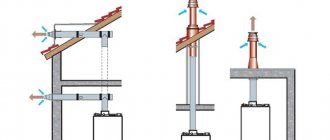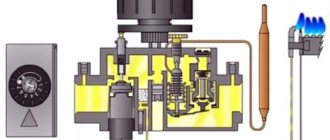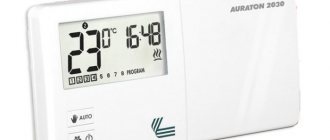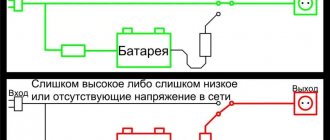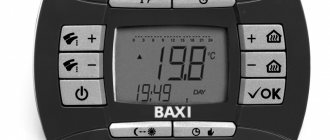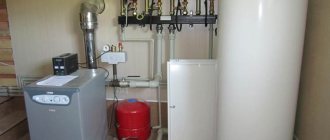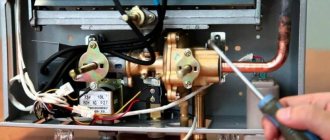Most modern gas boilers are energy dependent. Interruptions in the power supply completely stop their operation, which not only affects comfort, but also risks freezing of the coolant, and subsequently emergency depressurization of lines or heating devices. Fortunately, the solution is quite simple - installing a generator. Even the simplest models are often sufficient to ensure the operation of the automation of a boiler, circulation pump or turbine.
There are generators that run on gasoline, gas or diesel fuel, generators that are manually started or provide completely autonomous operation of the heating system, standard or inverter, synchronous or asynchronous - all these selection criteria are worth considering in more detail.
Minimum power values
This is the second criterion that deserves close attention (after choosing a standard or inverter version) when you need to buy a generator.
It is not difficult to determine its power. To do this, the starting and functional power of all connected devices is added up. A reserve of 20-30% is added to the result.
The minimum power for boiler operation is reflected in its documents. The indicators of electricity consumption and power consumption are also indicated there. As a rule, these parameters are in the range of 120-180 W. Approximately 150 W is required for the circulation pump and turbine, if it is installed in the boiler.
Calculation example:
One boiler is connected to the generator. Then for full operation a minimum of 0.5 - 0.62 W is required. This is the result of this arithmetic: 120-180 + 150 + 150 + 20-30%. It turns out 504-624 W.
Today, buyers have the opportunity to purchase devices with parameters of 0.6 - 7 kW. In 90% of situations, this is enough for devices producing 0.8 - 1 kW. In other cases, the total power of all equipment connected to the generator is calculated.
Model examples
There are plenty of brands of boilers. And users often wonder about the selection of a generator for a boiler of a particular brand.
Below are examples of certain boiler models and the most suitable modifications of gasoline generators.
First: Boiler - Baxi Ecofor 24.
Suitable generators:
- Hitachi E50. Price tag – 44 thousand rubles. Power – 4.2 kW.
- Huter DY2500L. Cost – 18 thousand rubles. Power – 2 kW.
Second: Boiler - Vaillant 240/3.
He needs a high-quality stabilizer, for example Resanta ASN-1500, especially if the electricity is turned off every 4-5 hours.
A suitable generator is Hyundai HHY 3000FE. It has an integrated AVR, modest fuel consumption and a power of 2.8 kW. Starts with a key and cable. Price tag – 42,000 rubles.
Third: Bosch Gaz 6000w device. It does not depend on the phase and for high-quality work is complemented by the Stihl 500I stabilizer
For complete stability and safety, it is accompanied by a SWATT PG7500 generator with a power of 6 - 6.5 kW. Cost – 40200 rub. It can work without breaks for 8 hours. Equipped with AVR.
Fourth: wall model Buderus Logamax U072-24K. This is a powerful dual-circuit modification with automatic electric ignition.
An inverter generator is required. For example, Enersol SG 3 with a power of 7-8 kW. It costs about 60,600 rubles.
Fifth: boiler Proterm 30 KLOM. This is a phase dependent floor standing model.
It is usually used in conjunction with the Stihl type stabilizer R 250T. A suitable generator option is Elitech BES 5000 E. It costs about 58,300 rubles. Power – 4-5 kW.
The sixth is the Navien Ice Turbo device - 10-30 kW.
It is optimal to use the ABP 4.2-230 Vkh-BG generator with a power of 4 kW and an average price tag of 55 thousand rubles.
If you need a reliable supply of fuel while camping or in the country when there is no electricity, then it is optimal to use a generator that produces a pure sine wave, the Huter HT 950A.
This is a convenient compact petrol model with low fuel consumption. It can work continuously for 6-8 hours if it is fully charged.
The engine here has one cylinder and two strokes. This guarantees smooth and stable operation of the entire generator.
Other advantages:
- The tank cap is located in such a way that it is convenient to control the fuel level and refuel.
- Overload protection available.
- Low noise levels.
- Special indicators allow you to monitor the oil level and control dangerous situations.
- Availability of replaceable air filter and muffler.
- The engine is reliably protected from external influences by a shock-resistant housing.
- There is an exhaust pipe that removes gases. Therefore, the device can only be used outdoors or indoors with strong ventilation.
- To use the device, no special skills or knowledge are required.
- Modest price - 6100 rubles.
Selection and calculation of the inverter
When calculating the required output power of the inverter, it must be taken into account that the presence of circulation pump electric motors in the load circuit will cause an increase in both constant current consumption, which determines the so-called power factor of the electric motor (cosine phi), and a significant current load at the time the pumps start. The maximum power consumption should not be more than 75% of the maximum power of the inverter output stage, especially for line-interactive devices in which the inverter operates constantly.
For an example of calculation, let's take a system consisting of a Baxi Fourtech gas boiler and two Oasis 25/2 pumps. Since the boiler electronics itself does not have an inductive load component, we will take its rated electrical power of 130 W into account without correction. The pumps have a rated power of 35 W. If the manufacturer did not also indicate the power consumption (in this case, 60 W), it could be defined as two times the nominal. Consequently, the consumption of two pumps will be 120 W in steady state, setting a double margin for the starting current and summing it up with the consumption of the boiler itself, we get a figure of 370 watts. Taking into account the power reserve for the inverter output stage, we will need a converter with a power of at least 0.5 kW.
If the inverter manufacturer indicates its power in kilovolt-amperes (kVA), you can convert it to kilowatts by knowing the power factor (cos φ) of the inverter itself. Thus, an uninterruptible power supply with cos φ=0.8 and a power of 1 kVA has a real power of 800 W.
The second parameter when choosing an uninterruptible power supply is the time during which it can supply power to the intended load. When calculating it, it must be taken into account that, on average, the functionality of the UPS output converter is maintained when no more than 75% of the battery capacity is exhausted. For example, if we use a battery with a capacity of 60 Ah, it can actually deliver no more than 45. Then, taking into account the average inverter efficiency of 80%, we get the following:
- The load from the previous example in steady state is 250 W, taking into account the losses in the inverter, we obtain the power taken from the battery at 312 W.
- At a nominal voltage of 12 V, this power means a current consumption of 26 A - a fully charged battery can supply the load for approximately 1.7 hours.
The type of uninterruptible power supply you choose determines both the budget and the features of the electrical network used. If the voltage in the network is relatively stable, it is enough to purchase an “offline” class UPS, but if the voltage fluctuates greatly, it would be more reasonable to either supplement it with an external stabilizer, or immediately buy an “online” or line-interactive class inverter. Since inverters of the required power usually use external batteries, it is worth checking what maximum charging current they can provide.
Considering that the optimal current for charging a battery is 10% of its nominal capacity, a device with a stated charging current of 6 A will work with batteries with a capacity of up to 60 ampere-hours.
Electric boiler design
In the most general case, the design of an electric boiler looks like this. There is a steel container with pipes for connecting the supply and return pipelines of the heating system. It has built-in devices of different designs for heating boiler water - induction coils, electrodes or heating elements.
Photo source: kit.byklimatkotlyelektricheskie
They determine the cost of the boiler unit (in descending order). In some cases, thermal insulation of parts of equipment in contact with heated water, a built-in circulation pump for it, and more are provided. There must be elements of automation (air vents, thermistors, pressure gauges, etc.), protection (against overheating, current leakage) and thermal power control.
Other criteria
Having solved the questions with the main technical points, pay attention to the following:
- Duration of work without pauses. Ordinary household models are not capable of working 24/7. After all, their engine needs cooling breaks. More massive and powerful units can withstand from 12 to 16 hours. Compact versions, weighing less than 10 kg, work without rest for 3-5 hours.
- Launch method. There are only two options: manual and automatic. The second guarantees complete autonomy of the heating network. But only expensive and powerful devices have this option.
- Noise indicators. They are determined by the functional engine speed, the ability to control them and the presence of sound insulation. Almost all low-power generators have a special casing that insulates sound.
FAQ
Some manufacturers have generator power in kVA, others in kW. What does this mean and how to correctly compare these characteristics when choosing a generator?
Kilovolt-amperes (kVA) indicate the total power of the generator. Apparent power consists of active (kilowatts - kW) and reactive power (kilovolt-amperes reactive-kVar). Active power matters to the consumer. The power ratio depends on the load. For household calculations, we can assume that the active power of the generator is 0.8 part of the total power. As a rule, you can take for translation: “kW=0.8*kVA”
And also, do not forget that the power of the generator should exceed 20-30% of the total power of consumers. Firstly, this will increase the service life of the generator. Secondly, you will be able to avoid generator shutdowns when turning on consumers with a power comparable to the generator.
What to look for when choosing a low-power gas generator?
Make sure that the engine is at least 40% more powerful than the alternator. For a 3 kVA alternator, you need a motor with a nameplate rating of at least 4.5 kW (6.2 hp). Otherwise, already at the rated load on the network, the engine will work for wear; In this case, large starting currents (grinder without soft start) and sudden load shutdowns (electric kettle) will have an even stronger effect.
I don’t overload the generator, I don’t violate maintenance deadlines. What else can be done to keep the generator running as long as possible?
It is extremely important to compare the power of the generator with the power of the load being switched off. Example: by abruptly disconnecting a 2 kW stove from the network, which is powered by a 3 kVA generator, you provoke a power surge
Which will affect both the gadgets being charged along the way and the “filling” of the alternator.
Synchronous and asynchronous system
To make the right choice, you should know their distinctive characteristics. They are set out in the following table:
Characteristics Synchronous Asynchronous Voltage and frequency Stable and high-precision retention Variation in a significant spectrum Electrical overloads High vulnerability to them when starting in standard mode. Resistance to them when starting in a similar mode. Cost Higher Lower Design Complex Simple Maintenance criteria Requires frequent and serious service and inspection Less demanding and unpretentious
Synchronous models are purchased when a scrupulously precise amount of current is required, and the voltage in the network often changes over a wide range.
Devices of the second category are a good budget option and protect the heating network from power surges. This is especially true in domestic conditions. But for this it is recommended to supplement the devices with uninterruptible power supplies (UPS).
How to choose and what to pay attention to?
The tips are as follows:
Pay attention to the engine type. The high-performance generator is equipped with a four-stroke engine. It operates up to 5 hours in autonomous mode. Does not require preparation of various oil mixtures.
View of the generator itself. Can be asynchronous or synchronous. The first one shows excellent resistance to external adverse conditions and works with devices with constant current values at startup. The second is resistant to starting overloads, has a more complex design and a high price tag. Necessary for working with inductive devices - welding, pump, compressor, and so on. An asynchronous generator is suitable for domestic use.
Take into account phasing. The devices are divided into two types - single-phase and three-phase. The latter are more powerful and functional, but also cost much more. A single-phase generator is suitable for solving simple problems.
Evaluate technical specifications. They talk in detail about the model you are interested in
Therefore, it is important to study the operating parameters so as not to regret the choice.
Why does the boiler go out when the power goes out?
In the event of power outages or accidents, the boiler automation is unable to perform its functions and immediately turns off the burner. This is ensured by the very design of the gas valve: it is pressed by the current passing through the coil.
If there is no current, it closes immediately.
Power outages, unfortunately, are not uncommon in Russia. So boiler owners have to sit in a cold house, although gas may be present in the mains. It cannot be lit without electricity, and tampering with the boiler can result in a fine from technical inspection authorities, as it leads to fire safety violations.
How long is uninterrupted power supply required?
According to current legislation, all residential private households belong to category 3 of uninterrupted power supply, which allows the energy supply organization to legally suspend power supply for up to 3 days.
As a rule, all emergency situations are resolved within 1 business day, but the most severe and prolonged accidents occur during periods of heavy snowfall. So in 2022, heavy snowfall led to a break in a high-voltage power line in the Pskov region. The accident took more than 3 days to resolve. 20,000 people were left without electricity in sub-zero outside temperatures.
Appearance of various designs of gasoline generator housings Source Pk-asia.kz
Choosing a heating boiler for your home
Today, the modern market offers a wide variety of boilers from foreign and domestic manufacturers. How to make the right choice and not make a mistake? Can't figure out the cost of a heating boiler for your home? You can, of course, entrust the choice of a boiler for heating your home to a qualified specialist if he will design a hot water supply and heating system. He will be able to ensure the best combination of system elements, tell you which boiler to choose and how to obtain the permits required for its installation. But it’s quite possible to figure out the priorities yourself when choosing a boiler that can economically heat your house.
For any home, the most important communications are: plumbing, energy, heating and sewerage. The quality of heating has a direct impact on the degree of comfort of the house and on how expensive its maintenance will be, especially during the heating period.
Selecting a generator for the boiler
For a gas boiler with an electronic control unit, it is preferable to purchase an inverter gas generator. Its price is noticeably higher than a simple one: 20-40 thousand rubles. versus 5-7 thousand, but it provides a sinusoidal voltage waveform and a stable frequency and voltage. In an inverter generator, an unpretentious input rectifier and a filter feed the inverter - a DC-to-AC voltage converter with excellent quality.
Before buying a generator, you need to find out what kind of power the boiler and pumps, if any, require. In the simplest case, it is enough to connect the terminals of the gas generator to the boiler power plug and start the generator engine. You can then light the boiler in the usual way.
When electricity becomes available, the generator can be turned off and switched to the power grid.
If the pumps in the system have three-phase motors, then the generator inverter must also be three-phase, and the boiler automation will be powered from one of the inverter phases. This applies to fairly powerful heating systems that heat medium-sized buildings and large cottages. Such a system must provide uninterrupted power supply to the boiler automation and pumps from an inverter operating together with the electrical network, through a bypass or even online. The generator is started in such systems to avoid draining the batteries for too long.
The power of the purchased generator should be selected with a 30-50% margin of the power consumed by the boiler together with the pumps. This will reduce the load on the generator engine and ensure its longevity.
If the boiler can operate from a gas generator, but has a separate neutral and phase, that is, it is not connected with a plug into a socket, but is mounted with a cable in the electrical panel, then a special generator connection diagram will be required, which prevents the simultaneous operation of the network and the generator. A single-phase inverter generator can be connected to such a boiler in any way, i.e. both of its terminals are equal in this case. The RCD should work with this connection.
The table shows examples of some 220 V gas generators.
| Model | Power | Reliability | Noise | Price | Weight | Launch | Fuel consumption | Working hours | Service | Reviews |
| DDE GG950DC | 625 W | 4 | 65 dB | 4400 rub. | 18.5 kg | manual | 0.72 l | 5.8 h | — | good |
| DENZEL DB950 | 650 W | 5 | 62 dB | 4800 rub. | 17 kg | manual | 0.7 l | 5 hours | — | great |
| FAVORITE PG950 | 950 W | 4 | — | 4990 rub. | 16 kg | manual | — | — | — | — |
| Most Power G800L | 650 W | 4 | quiet | 5027 rub. | 17 kg | manual | 0.69 l | 4 hours | There is | good |
| CHAMPION GG951DC | 650 W, inverter | 4 | very quiet | 5250 rub. | 19 kg | manual | 0.65 l | 4.6 h | There is | great |
| Hammer GNR800B | 600 W | 5 | quiet | 5990 rub. | 18 kg | manual | — | 8 hours | There is | great reviews |
| DDE DPG1201i | 1 kW, inverter | 4 | 58 dB | 6490 rub. | 12 kg | manual | — | 4.5 h | — | good |
| DDE DPG1201i | 1 kW, inverter | 4 | 65 dB | 6610 rub. | 13 kg | manual | — | 5 hours | — | normal |
| Eurolux G1200A | 1 kW | 4 | 75 dB | 6680 rub. | — | manual | 0.58 l | 9 hours | There is | very stable |
| Caliber BEG-900I | 900 W, inverter | 4 | 70 dB | 6590 rub. | 12 kg | manual | 0.52 l | 8 hours | There is | works well, lightweight |
| Redbo PT2500 | 2.2 kW | 5 | — | 6990 rub. | 38 kg | manual | — | 14 h | — | — |
| Eurolux G3600A | 2.5 kW | 5 | 77 dB | 9002 rub. | — | manual | 0.8 l | 18 h | There is | great |
| FAVORITE PG3000 | 2.5 kW, inverter | 5 | — | 9620 rub. | 36 kg | manual | — | 13:00 | There is | great |
| Kölner KGEG 5500 | 5.5 kW, inverter | 4 | 72 dB | 20493 rub. | 78 kg | manual | 1.6 l | 12 h | There is | good |
| CHAMPION GG650 | 5 kW | 5 | — | 22100 rub. | 77 kg | manual, starter | — | 13:00 | There is | very reliable |
| Bort BBG-6500 | 5.5 kW, inverter | 5 | 75 dB | 20750 rub. | 77 kg | manual, starter | 1.8 l | 12 h | There is | good |
| Daewoo Power Products GDA 12500E-3 | 10 kW, inverter, 220/380 V, 3 phases | 4 | — | 159,000 rub. | 165 kg | manual, starter, autostart | 4.2 l | 5 hours | There is | good |
| ENERGO EB 15.0/400-SLE | 12.6 kW, 220/380 V, 3 phases | 4 | 75 dB | 227700 rub. | 135 kg | starter, autostart (AVR) | 4 l | 6.2 h | There is | — |
| EUROPOWER EP16000TE (Honda) | 13 kW | 5 | 77 dB | RUR 293,791 | 152 kg | starter, autostart | 5.1 l | 4 hours | There is | good power plant |
| ENERGO EB 14.0/230-SLE | 11 kW, 220 V, 1 phase | 4 | 74 dB, with soundproof casing | RUB 554,480 | 930 kg | starter, autostart | 3.9 l | 6 hours | There is | — |
Connecting a gasoline generator
In this process, first of all, you need to take into account that the device runs on fuel. And after burning it should come out. For this purpose, an exhaust hood is created.
There should be free space around the device itself: 1-2 m. This provides access to the device for various purposes: refueling, manual starting or repair.
Before connecting the unit to the boiler, read the instructions. To connect to the network, a distribution panel is used, in which an automatic fuse is installed.
Both devices must be grounded. You can proceed according to the standard scheme:
This way you guarantee safety and the appearance of zero. These are mandatory conditions, without which the system will not be able to identify the flame and the boiler will not start.
If the generator is installed for the entire house, then a common network is used to ground it.
For both units to function correctly, the output must have a 50 Hz sine wave. If the indicators are different, it will be difficult to start the boiler. IHD can correct the situation.
In general, the algorithm for connecting a generator to a boiler has the following steps:
- Finding the necessary contacts in both devices (the diagram in the instructions helps with this).
- Connection and insulation of wires.
- Grounding of devices.
These operations look simple, but it’s better to trust them to professionals.
Rules for installing a UPS for a gas boiler
The UPS must not be placed near the cold water supply pipes of double-circuit boilers (condensation forms on them), or near heating pipes, so as not to interfere with the cooling efficiency of the inverter. Batteries should also not be exposed to low or extremely high temperatures.
The UPS cannot be used in conjunction with lead-acid batteries unless this is expressly stated in the operating instructions for this uninterruptible power supply. Differences in the charging current characteristics of lead-acid and gel batteries may cause the UPS charger to not operate properly.
It is advisable to use offline class devices in conjunction with a voltage stabilizer connected between them and the external network.
When using a phase-dependent gas boiler in a heating system together with a UPS, its output is connected to the load through an isolation transformer. This is due to the fact that when an inverter operates, both of its outputs are phases relative to ground, while a phase-dependent boiler requires a clearly defined phase and neutral of the supply. This is what an isolation transformer is used for, one of the terminals of the secondary winding of which is grounded.
Design features
A double-circuit heating boiler has a simple design, although it performs the function of a mini-boiler room. Both of its circuits can work either individually or in pairs, heating the house and providing hot water at the same time. The equipment in question consists of the following components:
- heat exchanger;
- boiler;
- heating elements;
- expansion tank;
- circulation pump;
- air vent;
- safety valve;
- automation;
- control unit.
Electric double-circuit models differ from single-circuit models by the presence of a built-in boiler in the design.
In appearance and main design features, electric boiler models can be:
- wall-mounted – compact and relatively light;
- floor-mounted – massive, with a high power rating (more than 60 kW).
As the name implies, heating equipment of the first group is mounted on walls or on specially installed metal frames. The second group of boilers is placed directly on the floor in a specially designated area. It should be noted that modern electric boilers are quite aesthetic and in no way can spoil the interior of the room.
According to the heating method, they can be divided into three groups:
- Heating elements - highly reliable, having one or more heating elements in the form of a metal tube inside the container;
- electrode (or ionic) – heating the coolant as it passes through a liquid alternating current medium. They have the ability to switch off independently in the event of a short circuit, a maximum increase in temperature and a decrease in the volume of water to a critical value;
- induction - operating thanks to inductance coils. Refers to energy-saving devices.
The first option refers to indirect heating of the coolant, and the second is considered as direct heating.
In terms of power, electric boilers intended for heating needs can be:
- single-phase (up to 12 kW);
- three-phase (more than 12 kW).
It is recommended to select power with the help of specialists, since only they can make a competent calculation. The method of selecting a boiler based on the area of the house is incorrect, since in addition to this parameter, a number of others are also taken into account (wall thickness, number of openings, orientation to the cardinal points, etc.).
As a rule, household heating units operate from a 220V network.
Pivot table
In the following table you can get acquainted with 9 popular and efficient UPSs on the market, which are divided into 3 subgroups. From the names you can understand that the main factor is the required uptime.
We also took into account the heated area of the house: the larger it is, the higher the power consumption of the boiler and pumps.
Each subgroup presents models for houses up to 100 sq.m (power consumption of boilers and pumps - 100-150 and 30-50 W) and for 100-200 sq.m. (150-200 and 60-100 W). 9 best UPS for gas boilers
| Group 1: UPS for short (up to 2 hours) and rare (2-4 times a year) outages | ||
| 1. |
Ideal for: a boiler in a small house up to 100 sq.m with a stable voltage of 220 V | 11000₽ |
| 2. |
Ideal for: boilers without external circulation pumps in a small house up to 100 sq.m. | 10800₽ |
| 3. |
Ideal for: connecting boilers and pumps in houses of 100-200 sq.m. | 12900₽ |
| Group 2: UPS for long-term (from 2 hours) and frequent (from 5 times a year) outages | ||
| 4. |
Ideal for: sensitive boilers and pumps in houses of 100-200 sq.m. with unstable voltage | 16800₽ |
| 5. |
Ideal for: boilers and pumps in houses of 100-200 sq.m with stable voltage | 12900₽ |
| 6. |
Ideal for: boilers with built-in pump in houses up to 100 sq.m. | 10325₽ |
| UPS for combined operation with an electricity generator | ||
| 7. |
Ideal for: uninterruptible power supply to boilers and pumps with unstable voltage | 19350₽ |
| 8. |
Ideal for: boilers with ultra-low voltage and high noise requirements | 17700₽ |
| 9. |
Ideal for: expensive boilers with sensitive electronics | 21600₽ |
Now let’s take a closer look at the characteristics of the models, study customer reviews and watch video reviews.
Rating of electric generators
The presence of an electric generator instantly solves the problem of blackout. Such products are in steadily growing demand, so more and more offers are appearing on the market. The VyborExpert project team compiled a list of determining factors by which the top rating was compiled:
- Type of fuel consumed;
- Fuel tank capacity;
- Power in minimum and maximum indicators;
- Quality of generated current;
- Intended use;
- Battery life;
- Two- or three-phase type;
- Additional options;
- Size, weight;
- Unpretentiousness in maintenance;
- Reliability of design and service life;
- Permissible temperature conditions for uninterrupted operation;
- Economical current consumption;
- Noisy when active;
- Protection from moisture, dust, interruptions, overheating.
The expert review included those models that demonstrate the best specified parameters, while their price corresponds to the build quality and functionality. The collection of information included the opinions of experts in this field, positive customer reviews, and test results.
The best heat pumps
Types of UPS
According to their design, uninterruptible power supplies are divided into three types:
Online inverters for boilers, unlike offline ones, have a built-in stabilizer at the input and, thanks to this, switch to backing up power from the battery only when the network power is turned off. When its voltage deviates from 220 V, the stabilizer operates. This scheme is more expensive, but also more effective when used in a network with strong daily voltage fluctuations (for example, a low-power substation in the private sector). An offline inverter under such conditions will go into standby mode too often, requiring the installation of a separate voltage stabilizer in front of it.
Line-interactive inverters are the most advanced class of devices. In them, the input voltage is immediately converted into direct current, supplied to the output inverter, and the battery is connected between the blocks. A conventional welding inverter is constructed in a similar way (if you do not take into account the battery). Thus, the supply voltage is always stabilized, and when it is turned off, there is no delay in switching the UPS output from the external network to the inverter.
how to connect the boiler to the generator
This article deals only with the problem of connecting gas boilers to a generator.
And you are reading this article for two reasons:
- You already have a boiler and a generator, and the boiler does not want to work with the generator, while the gas burner tries to ignite, but goes out after 3-5 seconds.
You are just planning to buy a generator to power the boiler in the event of a centralized power supply failure.
There is only one reason - the absence of a hard zero on the generator. Every modern boiler contains a device that controls the presence of flame in the combustion chamber. This is called "gas control". The principle of operation is to continuously measure the ionization current flowing between a metal pin insulated from the burner body and the combustion chamber body itself. The “phase” is supplied to the pin, and the phase is 220 volts in relation to the “ground”, and the body is the “ground” - 0 volts. The boiler control board measures the ionization current, and if it is within acceptable limits, then everything is fine, gas is supplied, there is a flame, the gas burns, there is no danger. If there is no ionization current, or it is small (less than 20mA), the control board interprets it as the absence of flame in the combustion chamber and gives a signal to re-ignite the burner, and so on several times. If the ionization current does not appear, the gas supply is blocked for safety reasons.
In Generators that do not have a zero, there is a sinusoidal voltage at the output with an amplitude of 220 volts, but this voltage, or more correctly, the potential difference, is present between two “holes” in the output socket. And if you measure the potential difference between the “housing” of the generator and each of the “holes” of the socket with a voltmeter, then 220 volts will not work - but the tester will show 110 and 110 volts at idle, and for example 50 and 170 volts under load. If the power plug from a gas boiler is plugged into such a generator, then not 220 volts, but 110 will be supplied to the pin. This voltage will not be enough for the normal value of the ionization current and the gas control system will work.
What to do? The conclusion suggests itself - you just need to connect one of the holes in the generator output socket to zero (the zero bus of the house). But this cannot be done for inverter generators; the zero bus is connected to the ground bus at the entrance to the house. Therefore, it turns out that you are shorting one of the outputs in the socket to the same generator housing, because According to operating rules, the generator housing must be grounded. In this case, there is a high probability of failure of the generator coil.
There is only one way out - installing an isolating transformer. The connection diagram is shown in Fig. Physically, we separate the output circuit of the generator from the input circuit of the boiler and have every right to connect one of the transformer outputs to the zero bus of the house. Such a connection will not have any negative effect on the generator coils. Another advantage when installing an isolation transformer is its ability to smooth out sudden voltage surges. A transformer is a coil, and a coil is an inductance, and inductance always resists a sharp rise (edge) of a signal.
BAXi specialists (link to the BAXI boiler manufacturer forum website) advise solving this problem by using a specially designed Teplocom GF device.
Method number 3 - Homemade stations
Also, many craftsmen create homemade stations (usually based on a gas generator), which they then sell.
All this indicates that you can independently make a power plant from available materials and use it for your own purposes.
Next, let's look at how you can make the device yourself.
We recommend: Cooling towers of open and closed types: their design, operating modes, photos
Based on a thermoelectric generator.
The first option is a power plant based on a Peltier plate. Let us immediately note that a device made at home is only suitable for charging a phone, a flashlight, or for lighting using LED lamps.
For production you will need:
- A metal body that will play the role of a furnace;
- Peltier plate (purchased separately);
- Voltage regulator with installed USB output;
- A heat exchanger or just a fan to provide cooling (you can take a computer cooler).
Making a power plant is very simple:
- We make a stove. We take a metal box (for example, a computer case) and unfold it so that the oven does not have a bottom. We make holes in the walls below for air supply. At the top you can install a grate on which you can place a kettle, etc.
- We mount the plate on the back wall;
- We mount the cooler on top of the plate;
- We connect a voltage regulator to the terminals from the plate, from which we power the cooler, and also draw terminals for connecting consumers.
POPULAR WITH READERS: What are smart sockets, their types, design and operating principle
It works simply: we light the wood, and as the plate heats up, electricity will begin to be generated at its terminals, which will be supplied to the voltage regulator. The cooler will start working from it, providing cooling of the plate.
All that remains is to connect the consumers and monitor the combustion process in the stove (add firewood in a timely manner).
Based on a gas generator.
The second way to make a power plant is to make a gas generator. Such a device is much more difficult to manufacture, but the energy output is much greater.
To make it you will need:
- Cylindrical container (for example, a disassembled gas cylinder). It will play the role of a stove, so hatches should be provided for loading fuel and cleaning solid combustion products, as well as an air supply (a fan will be required for forced supply to ensure a better combustion process) and an outlet for gas;
- A cooling radiator (can be made in the form of a coil) in which the gas will be cooled;
- Container for creating a “Cyclone” type filter;
- Container for creating a fine gas filter;
- Gasoline generator set (but you can just take any gasoline engine, as well as a regular 220 V asynchronous electric motor).
After this, everything must be connected into a single structure. From the boiler, gas should flow to the cooling radiator, and then to the “Cyclone” and a fine filter. And only after that the resulting gas is supplied to the engine.
This is a schematic diagram of the manufacture of a gas generator. Execution can be very different.
For example, it is possible to install a mechanism for forced supply of solid fuel from a bunker, which, by the way, will also be powered by a generator, as well as all kinds of control devices.
When creating a power plant based on the Peltier effect, no special problems will arise, since the circuit is simple. The only thing is that you should take some safety measures, since the fire in such a stove is almost open.
But when creating a gas generator, many nuances should be taken into account, among them is ensuring tightness at all connections of the system through which gas passes.
In order for the internal combustion engine to operate normally, you should take care of high-quality gas purification (the presence of impurities in it is unacceptable).
The gas generator is a bulky design, so it is necessary to choose the right place for it, as well as ensure normal ventilation if it is installed indoors.
Since such power plants are not new, and they have been manufactured by amateurs for a relatively long time, a lot of reviews have accumulated about them.
Basically, they are all positive. Even a homemade stove with a Peltier element is noted to completely cope with the task. As for gas generators, a clear example here is the installation of such devices even on modern cars, which indicates their effectiveness.
How to insure the operation of the boiler
In such conditions, many boiler owners prefer to back up the power supply for their heating. There are opportunities for this, it is not prohibited, and the market offers choice. Batteries can be used in conjunction with inverters. This device resembles a computer UPS, only slightly more powerful. As a rule, boiler automation consumes quite a bit of electrical power, but this already depends on the overall configuration of the heating system. If it has pumps, then their operation is often necessary, that is, they do not simply increase the efficiency of coolant circulation, but are included in the heating design as a necessary element.
Then the overall energy consumption increases.
Also, in some cases, autonomous generators based on internal combustion engines may be suitable: gasoline or diesel generators. Gasoline generators can be powered from a gas main if a particular model allows the carburetor to be replaced with a special device. There are models that already provide for switching from gasoline to gas. There are generators with gas equipment that can be connected to natural or liquefied gas.
Of course, to power an autonomous power plant designed to generate electricity for the needs of a gas boiler and other heating equipment, a gas version of the engine would be best suited. With sufficient power - from 10 kW - such a power plant could back up the entire power grid of a cottage during a power outage. The market offers a lot, but this solution is not cheap.
The boiler automation system consumes power of about one to two hundred watts - what is needed to power the gas electric valve and draft, flame and pressure sensors in the line. If the system has pumps, then the power consumption increases significantly: a household single-phase heating pump has a power consumption of 300 watts and above. Under such conditions, the load on the inverter increases and very expensive equipment is required.
Many boiler owners are forced to look for cheap solutions - this is due to the level of average income in Russia. Is it possible to use a gas generator for a boiler? This solution seems very effective: the cost of gasoline generators is low, and the power is sufficient in many cases.
Unfortunately, the stability, frequency and shape of the output voltage provided by a gasoline generator for a gas boiler may not be sufficient in the case of a cheap model.
If an inexpensive generator powers boiler automation in a system without pumps, then its power is quite sufficient, but a non-sinusoidal and “jumping” voltage can lead to unstable operation of the gas valve or electronics power source. Modern power supplies are all pulsed; they are quite tolerant of power supply errors from the mains, but when powered by an autonomous generator with a low-quality voltage, they can operate unstably and even fail. Control units and controllers consume power of the order of several tens of watts.
Standard or inverter
The inverter differs from a standard household generator in the presence of an inverter system and an electronic stabilizer. Thanks to this system, the AC sine wave has no distortion and is stabilized to an ideal frequency of 50 Hz. Of course, inverter models are 20-50% more expensive than regular ones.
Inverter model Daewoo GDA 1500i with manual start.
In general, the advantages of inverter generators for a gas boiler are:
- higher quality output electricity, which is safer for boiler automation;
- the operation of the generator is adjusted automatically depending on the load size, which often makes it possible to reduce the operating speed of the internal combustion engine and, accordingly, its service life and fuel consumption;
- inverter devices are compact in size;
- lower levels of vibration and noise (up to 50-60 dB) allow you to feel comfortable even in the same room with a running electric generator
Please note that there are currently no inverter models larger than 6 kW. To operate the generator, you need a charged battery capacity, which, under higher loads than the maximum permissible (for example, at 6 kW at 4 kW maximum), will quickly discharge and you will have to turn off some of the devices for recharging.
In addition, the battery is part of a single structure and after its service life has expired (4-9 years depending on operating conditions), it will be necessary to replace the entire inverter unit assembly.
How to choose a water softener for a gas boiler and extend the life of the heat exchanger

